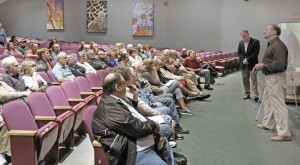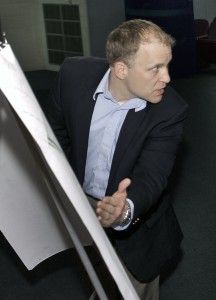
Westfield City Engineer Mark Cressotti, right foreground, and Matthew J. Chase, right background, project engineer for Vanasse Hangen Brustlin, Inc., of Worcester, present an illustrated drawing of the newly redesigned intersection of North Elm and Notre Dame streets during a meeting in the Westfield High School auditorium, as more than 50 residents listen. (Photo by Frederick Gore)
WESTFIELD – More than 70 residents attended an informational meeting last night at the Westfield High School Auditorium to hear details of proposed improvements to the intersection of North Elm Street and Notre Dame Street.
City Engineer Mark Cressotti, himself a resident of Prospect Hill, and Matthew Chase, P.E. of Vanasse Hangen Brustlin (VHB) Inc., detailed the project which is intended to relieve congestion at that intersection.

Matthew J. Chase, project manager for the Vanasse Hangen Brustlin, Inc. a transportation and land development service, explains an illustrated drawing of the redesigned intersection at North Elm and Notre Dame streets during an informational meeting at Westfield High School last night. (Photo by Frederick Gore)
Cressotti said the concept is to add dedicated left turn lanes to both the northbound and southbound traffic on North Elm Street. Chase said that the bridge over Powdermill Brook limits the addition for a southbound left turn lane to about 50 feet, sufficient length to queue three to four vehicles intending to turn onto lower Notre Dame Street.
The northbound left-turn lane will be about 250 feet long, sufficient to queue 20 vehicles intending to turn left to upper Notre Dame Street.
The traffic improvement project also includes widening Upper Notre Dame Street at the North Elm Street intersection to accommodate motorists, in particular trucks, intending to make a right turn onto the southbound lanes of North Elm Street.
At times it seems that there were several different information meetings as diverse groups of residents asked question about the impact of the project on their specific neighborhoods.
Residents offered a number of suggestions to amend the scope of work to address their specific issue.

An illustrated drawing of the redesigned intersection at North Elm and Notre Dame streets was unveiled last night during an informational meeting in the Westfield High School Auditorium. (Photo by Frederick Gore)
Cressotti said that the construction of the traffic improvements will not begin until the Pochassic Street (Drug Store Hill) Bridge is completed. That work is expected to be done by June and the rebuilt bridge opened to all traffic.
One resident asked if opening the Pochassic Street Bridge would trigger closure of the upper Notre Dame Street Bridge over the Pioneer Valley Railroad by state officials, again leaving Prospect Hill residents with just one means of egress off the hill.
Cressotti said that typically there is a process by the State Department of Transportation (DOT) if it discovers structural issues with a bridge, beginning with posting a weight limit for vehicles.
“The Pochassic Street Bridge was posted a year or more before they closed it and the weight limit kept going down,” Cressotti said. “The Notre Dame Bridge is currently not posted (with a weight limit) at all.”
Chase said that in addition to the left-turn lane additions, the intersection will be raised by about four inches to improve drainage.
Several residents said raising the elevation of the intersection will push storm water down lower Notre Dame Street which, they claimed, already has drainage which is not sufficient to collect stormwater.
Cressotti said the problem is that drainage in the intersection and lower Notre Dame Street is a gravity system which empties into Powdermill Brook and that over time the streambed has risen because of siltation, half burying the drainage outflow. The other problem with the current drainage system is that during significant rain events the water lever of the brook rises and at times could backflow into the drainage system.
Pastor Wally of the Full Gospel Church on Union Street, a former engineer, suggested that a pump station be added to push stormwater through a pressurized line into the brook.
Chase said that the city intends to extend a center turn lane beyond the initial 250 feet down North Elm Street to the area of the Westwood Building. That center turn lane would provide a queue for motorist intending to make left turns onto either side of the road. Those turning area would be designated by the installation of rumble strips.
Stephen Hitchcock, the owner of Industrial Precision Corporation on Southampton Road, suggested eliminating all southbound left turns and requiring motorists to go to the round-about turn lane at the Great River Bridge to access streets, and neighborhoods, off Union Street.
Many of the motorists make left turns off the southbound lane of North Elm Street, especially at lower Notre Dame Street, using those residential streets as cut-through routes to reach Union Street.
Residents cited truck traffic taking those routes to avoid having to cross the Great River Bridge to turn around at the traffic control light in front of Holy Trinity Church, then having to cross the bridge a second time to reach Union Street.
Cressotti said that planners will address that suggestion and added that extending the drainage system to the south along North Elm Street may elevate ponding issues at the intersection.
Jeanne Morganelli of Atwater Street questioned Cressotti about the impact of the traffic improvement project on neighborhoods off Prospect Street, residential streets used by WHS students to avoid traffic congestion on Montgomery Road, a problem that will increase when the Pochassic Street Bridge is opened.
“Westfield High kids will be racing down Foch Avenue and Pine Street to Prospect, then onto my street so they can make a left turn down Parker Avenue to avoid the traffic backed up Montgomery Street,” Morganelli said.
Cressotti suggested parking vehicles on the roadside to create traffic calming choke points as a means of slowing vehicles.
Lora Martone of Lower Notre Dame Street asked the engineers “to listen to the people who live here, to our safety concerns. Listen to what we say.”

